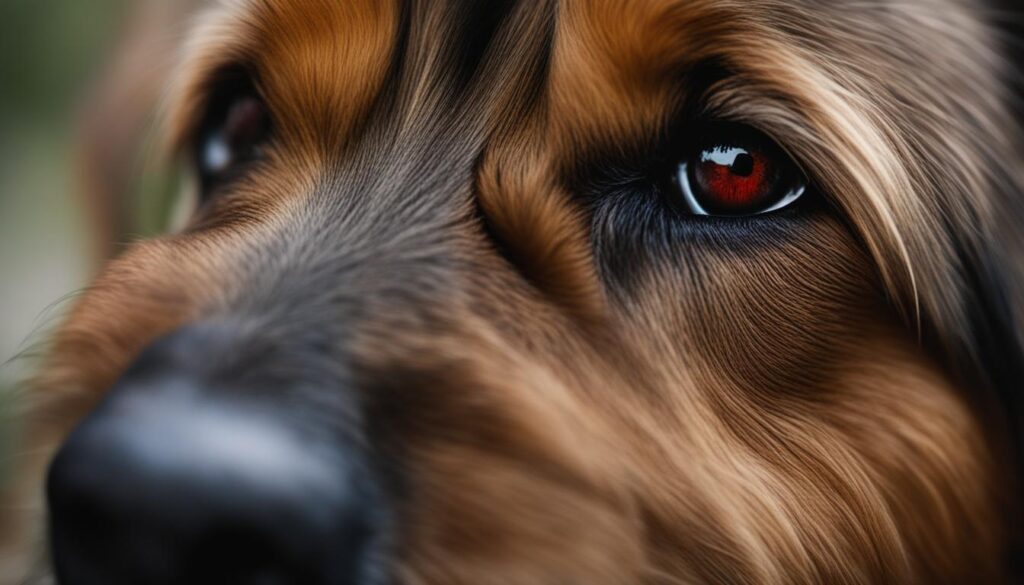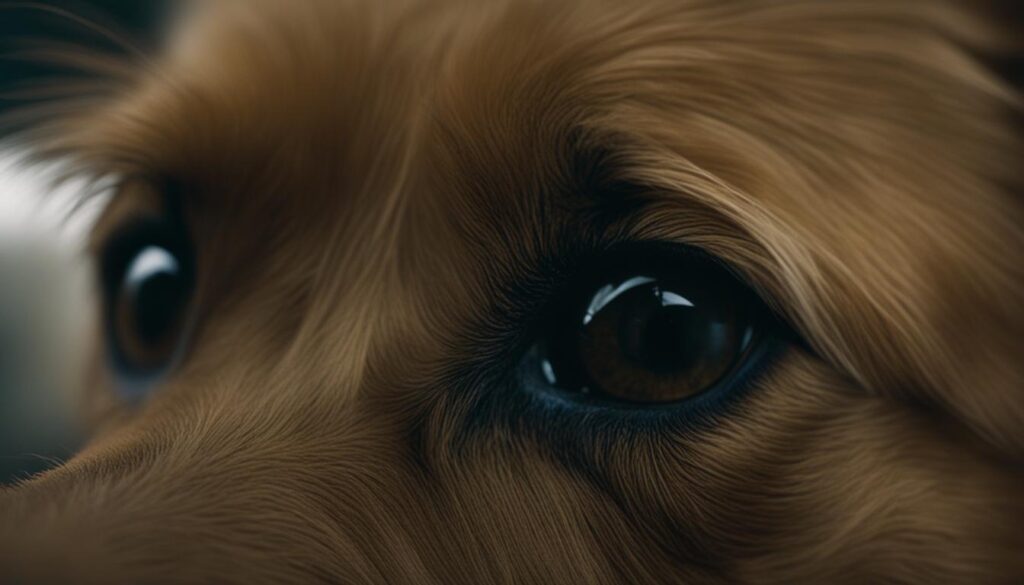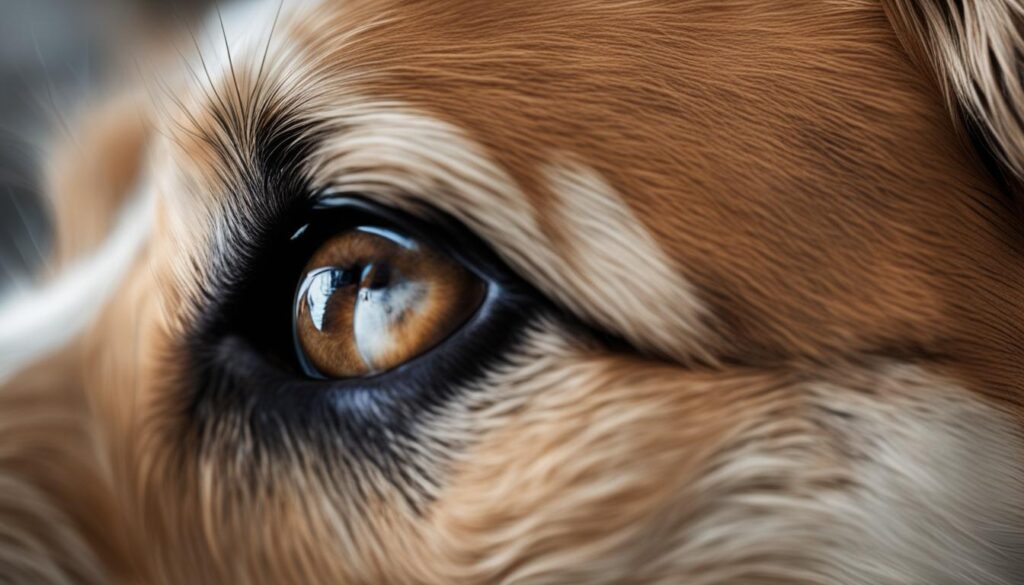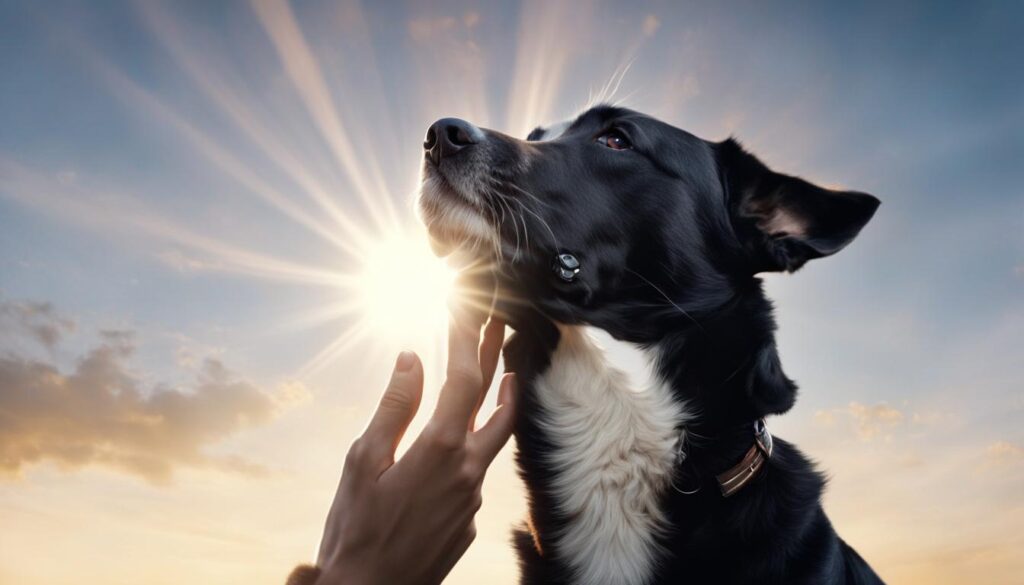As pet owners, we often worry about the health and well-being of our furry friends. When it comes to our dogs’ eyes, it’s essential to be aware of potential issues that can arise, including styes. But can dogs get styes? Let’s explore the world of pet eye health to find out.
Dog eye infections and diseases are not uncommon, and styes are one of the conditions that can affect our canine companions. Styes appear as red bumps on the eyelids and are caused by inflammation of the eyelid’s glands, such as the glands of Zeis and Moll and the Meibomian gland. If left untreated, styes can worsen and impact the entire eyelid.
To ensure the best care for our dogs, it’s crucial to recognize the signs of styes in dogs and take appropriate measures to prevent and treat this condition. By understanding the causes and treatment options, we can promote our dogs’ eye health and overall well-being.
Key Takeaways:
- Styes can affect dogs and are caused by inflammation of the eyelid’s glands.
- Signs of styes in dogs include red bumps on the eyelids.
- Proper treatment involves a warm compress and, in some cases, medication prescribed by a veterinarian.
- Preventing styes in dogs involves good eye hygiene and minimizing exposure to irritants.
- Veterinary care should be sought if there are persistent or worsening symptoms.
Understanding Canine Eye Health

Canine eye health is crucial for the overall well-being of our dogs. Just like humans, dogs can suffer from a variety of eye conditions. It is important for pet owners to be aware of these conditions and take proactive measures to maintain their dog’s eye health. Regular eye care, such as cleaning around the eyes and regular visits to the veterinarian, can help prevent and detect any issues early on.
Common Eye Conditions in Dogs
There are several common eye conditions that can affect dogs. These include:
- Conjunctivitis: Also known as “pink eye,” conjunctivitis is the inflammation of the conjunctiva, the thin tissue that covers the front of the eye. It can cause redness, discharge, and discomfort for dogs.
- Corneal ulcers: Corneal ulcers are open sores on the surface of the cornea, the clear outer layer of the eye. They can be caused by scratches, infections, or foreign objects.
- Cataracts: Cataracts are cloudy areas that form in the lens of the eye, causing vision impairment. They can be hereditary or develop as a result of other underlying health conditions.
- Glaucoma: Glaucoma is a condition characterized by increased pressure within the eye, which can damage the optic nerve and lead to vision loss. It is a serious condition that requires prompt veterinary attention.
Understanding these common eye conditions can help pet owners recognize potential issues and seek veterinary care when necessary.
Proactive Dog Eye Care
To maintain canine eye health, it is important to incorporate regular eye care into your dog’s routine. This includes:
- Gently cleaning around the eyes to remove any dirt or discharge buildup.
- Checking for any signs of redness, swelling, or discharge.
- Ensuring your dog’s environment is free from potential eye irritants, such as dust or chemicals.
- Scheduling regular visits to the veterinarian for comprehensive eye examinations.
By being proactive in dog eye care, pet owners can help prevent and detect any issues early on, promoting better eye health for their furry companions.
Quote: “Regular eye care and veterinary check-ups are essential for maintaining the overall health and well-being of our dogs.” – Dr. Jennifer Miller, Veterinarian
What is a Stye in Dogs?

A stye, medically known as a hordeolum, is a common eye condition that can affect dogs. It appears as a red bump on the dog’s eyelid and is caused by inflammation of the eyelid’s glands. Styes are a type of blepharitis, which is the inflammation of the eyelid. The most common cause of styes in dogs is the inflammation of the eyelid’s glands, such as the glands of Zeis, Moll, and the Meibomian gland.
Styes in dogs can be easily recognized as small red bumps on the upper or lower eyelid. They may cause discomfort and irritation to the affected area. It is important for pet owners to be able to distinguish between a stye and other eye conditions, such as cherry eye, which may require different treatments. Keeping an eye out for signs of styes in dogs is essential for early detection and appropriate management.
Here is an example of what a stye may look like:
Signs of Styes in Dogs:
- Redness and swelling on the eyelid
- A small bump or pimple-like growth on the eyelid
- Tenderness and discomfort when touched
- Excessive blinking or rubbing of the affected eye
- Increased tear production
If you notice any of these signs in your dog’s eye, it is important to consult with a veterinarian for a proper diagnosis and treatment plan. Delaying treatment can lead to further complications and discomfort for your furry friend.
“Styes in dogs are a common eye problem caused by inflammation of the eyelid’s glands. Recognizing the signs and seeking veterinary care is essential for effective treatment and a speedy recovery.” – Dr. Sarah Johnson
Treating Dog Eyelid Styes

When it comes to treating dog eyelid styes, there are several options available depending on the severity and underlying cause. For mild styes, a simple and effective treatment is using a warm compress. Applying a warm damp washcloth to the affected eye for a few minutes, several times a day can help reduce inflammation and promote healing. The warmth helps to increase blood circulation to the area, which aids in the healing process.
If the stye does not improve or if it is more severe, it is important to consult with a veterinarian. They may prescribe medication to reduce swelling and treat any underlying infection. Following the veterinarian’s instructions and administering the medication properly is crucial to ensure effective treatment and a speedy recovery for your furry friend.
Remember, always consult with a veterinarian before starting any treatment for your dog’s stye. They will be able to provide you with the best course of action based on your dog’s specific condition.
| Treatment Option | Description |
|---|---|
| Warm Compress | Applying a warm damp washcloth to the affected eye to reduce inflammation and promote healing. |
| Medication | Prescribed by a veterinarian to reduce swelling and treat underlying infection. |
| Surgical Intervention | In severe cases, surgical removal of the stye may be necessary. |
Each treatment option carries its own benefits and considerations, and the appropriate choice will depend on the individual circumstances of the stye. Your veterinarian will be able to guide you in selecting the most suitable treatment for your dog.
Preventing Dog Eyelid Styes
While it may not be possible to completely prevent styes in dogs, there are steps that pet owners can take to minimize the risk. Good eye hygiene is essential in preventing styes. This includes keeping the area around the eyes clean and free of debris. Regular grooming, especially around the eyes, can help remove excess hair that may contribute to stye formation.
Pet owners should also be cautious about allowing their dogs to stick their heads out of car windows. This seemingly innocent activity can expose the eyes to potential irritants, increasing the chances of developing a stye.
By practicing diligent eye care and taking preventive measures, pet owners can significantly reduce the likelihood of their dogs developing styes, ensuring their furry friends enjoy optimal eye health.
Regular grooming, especially around the eyes, can help remove excess hair that may contribute to stye formation.
When to Seek Veterinary Care

As a pet owner, it’s important to be vigilant about your dog’s eye health. Recognizing the signs that indicate a need for veterinary care is crucial when it comes to dog eye problems, including styes. Ignoring the symptoms or delaying treatment can lead to complications and discomfort for your furry friend.
- Persistent Swelling: If you notice that your dog’s eyelid is consistently swollen or the swelling worsens over time, it’s essential to seek veterinary care. This could be a sign of an underlying infection or a more serious eye condition.
- Change in Eye Color: Any changes in your dog’s eye color should be a cause for concern. If you notice a noticeable change in the color of the iris or the appearance of a cloudy or hazy film over the eye, it’s best to consult with a veterinarian. This could indicate a more serious eye problem that requires immediate attention.
- Behavioral Changes: Keep an eye out for any changes in your dog’s behavior, such as excessive scratching or aggression towards the affected eye. These behaviors may indicate discomfort or pain and should be addressed by a professional.
If your dog’s stye persists or worsens over time, it’s highly recommended to have a veterinarian assess the condition and provide appropriate treatment. Prompt veterinary care can help prevent complications and ensure the overall health and well-being of your dog.
The Role of Diet in Eye Health

A balanced diet is essential for maintaining the overall health and well-being of dogs, including their eye health. By providing the necessary nutrients, pet owners can promote healthy eyes and reduce the risk of dog eye diseases. Some key nutrients that play a crucial role in canine eye health are antioxidants, omega-3 fatty acids, and zinc.
Antioxidants, such as vitamins C and E, help protect the eyes from oxidative stress and damage caused by free radicals. These powerful antioxidants can be found in fruits and vegetables like blueberries, spinach, and carrots. Including these foods in your dog’s diet can provide essential eye-protecting benefits.
Omega-3 fatty acids, commonly found in fish oil supplements and fatty fish like salmon, are beneficial for eye health. These fatty acids help maintain the integrity of the retinal structure and reduce the risk of age-related eye diseases in dogs. Adding a fish oil supplement or incorporating fish into your dog’s diet can contribute to their overall eye health.
Zinc is another important nutrient for canine eye health. It plays a role in maintaining proper immune function and promoting wound healing. Foods rich in zinc include meat, poultry, fish, and legumes. Ensuring an adequate intake of zinc can support the overall health of your dog’s eyes.
To provide the best nutrition for your dog’s eye health, it is recommended to consult with a veterinarian. They can assess your dog’s individual nutritional needs and provide guidance on proper diet and supplementation.
| Nutrient | Sources |
|---|---|
| Antioxidants (vitamins C and E) | Fruits (blueberries, carrots), vegetables (spinach), supplements |
| Omega-3 fatty acids | Salmon, fish oil supplements |
| Zinc | Meat, poultry, fish, legumes |
By incorporating these essential nutrients into your dog’s diet, you can help maintain their canine eye health and reduce the risk of dog eye diseases. However, it is important to remember that a balanced diet alone cannot replace regular veterinary care. Regular check-ups and eye examinations by a veterinarian are crucial for early detection and prevention of any potential eye problems in dogs.
Emotional Support and Recovery

Eye conditions, including styes, can cause discomfort and distress for dogs. During the recovery process, it is important for pet owners to provide emotional support to their furry friends. Spending quality time with the dog, providing gentle petting and reassurance, can help alleviate anxiety and promote a faster recovery. Creating a comfortable and safe environment for the dog, particularly if the eye is sensitive to light, can also contribute to their emotional well-being. Engaging the dog in light activities and providing mental stimulation can help distract them from the discomfort and aid in their overall recovery.
Recovering from a stye can be a challenging time for a dog, both physically and emotionally. As a pet owner, it’s essential to be patient and understanding during this period. Dogs can become anxious or irritable due to the discomfort they may experience. By offering emotional support and reassurance, you can help your dog feel more secure and at ease.
One effective way to provide emotional support is to spend quality time with your furry friend. Sit with them, pet them gently, and talk to them in a calm and soothing tone. This physical contact can help your dog feel loved and cared for, which can contribute to their emotional well-being and overall recovery.
In addition to physical contact, creating a comfortable environment for your dog is crucial. If the eye affected by the stye is sensitive to light, consider dimming the lights or drawing curtains to reduce brightness. Providing a cozy and quiet space with their favorite toys and bedding can help them feel safe and secure.
Engaging your dog in light activities can also aid in their emotional recovery. Take them on short, gentle walks or play with them using interactive toys that are not strenuous on their eyes. Mental stimulation, such as puzzle toys or training sessions, can help distract them from the discomfort of the stye and keep their minds occupied.
“Recovery from a stye can be a challenging time for dogs, but with emotional support and a comfortable environment, they can heal both physically and emotionally.” – Dr. Emily Johnson, Veterinarian
Remember to consult with your veterinarian for specific guidance on providing emotional support during the recovery process. They can offer tailored advice based on your dog’s individual needs and condition.
By providing emotional support and creating a nurturing environment for your dog, you can help them navigate the recovery process more smoothly. Your love and care will not only contribute to their emotional well-being but also aid in their overall healing.
Emotional Support Techniques for Dogs with Styes
| Techniques | Benefits |
|---|---|
| Spending quality time and gentle petting | Alleviates anxiety and promotes a faster recovery |
| Creating a comfortable and safe environment | Reduces stress and promotes emotional well-being |
| Engaging in light activities and mental stimulation | Distracts from discomfort and aids overall recovery |
Post-Recovery Care and Monitoring
After a stye has resolved, it is crucial to continue monitoring your dog’s eye health and providing appropriate care to ensure a complete recovery. Regular eye checks should be a part of your dog’s routine care, with careful attention given to any changes in the appearance or behavior of the eyes. Keeping the area around the eyes clean and free from discharge is essential for preventing any further complications.
During the post-recovery phase, it is important to be vigilant for any signs of redness, swelling, or discomfort. If you notice any of these symptoms, it is crucial to promptly report them to your veterinarian for proper evaluation and treatment. Regular follow-up visits to the veterinarian can provide reassurance and peace of mind, ensuring that the stye has fully resolved and that your dog’s eye health is stable.
Post-Recovery Care Checklist:
- Continue to clean the area around the eyes regularly to maintain good eye hygiene.
- Keep an eye out for any signs of redness, swelling, or discomfort.
- If your dog shows any signs of eye irritation or inflammation, consult your veterinarian immediately.
- Follow your veterinarian’s instructions regarding any additional care or medications.
- Attend regular follow-up visits to monitor your dog’s eye health and ensure complete recovery.
Remember, the well-being of your dog’s eyes is an essential part of their overall health. By providing post-recovery care and monitoring, you can help prevent any future eye problems and ensure that your furry friend enjoys clear and healthy eyes for years to come.
Holistic Approach to Dog Health
Maintaining a holistic approach to dog health is crucial for preventing and managing eye problems, including styes. It involves addressing not only the physical health of our furry friends but also their emotional and environmental well-being. By taking a comprehensive approach to dog care, we can ensure that our dogs lead happy and healthy lives.
Creating a safe and stimulating environment is a key aspect of holistic pet care. Providing a comfortable living space, enriching toys and activities, and ensuring proper socialization all contribute to the overall well-being of our dogs. A stress-free environment promotes better eye health and reduces the risk of eye problems like styes.
A balanced diet is another important component of holistic dog health. Proper nutrition with essential nutrients, vitamins, and minerals helps strengthen the immune system and supports the overall health of the eyes. Including antioxidant-rich foods, such as fruits and vegetables, can provide additional protection against eye diseases.
Regular veterinary care is crucial for maintaining the holistic health of our dogs. Scheduled check-ups allow veterinarians to detect any potential eye problems early on and provide appropriate treatment. They can also offer advice on preventative measures, such as proper eye hygiene and recommended supplements, to minimize the risk of styes and other eye conditions.
In addition to physical health, holistic pet care also emphasizes the emotional well-being of our dogs. Ensuring they feel loved, secure, and mentally stimulated is vital for their overall health and happiness. This can be achieved through regular exercise, engaging activities, training, and positive reinforcement.
By adopting a holistic approach to dog health, pet owners can create a balanced and supportive lifestyle for their furry companions. From providing a nurturing environment to ensuring proper nutrition and regular veterinary care, every aspect of their well-being is taken into account. This comprehensive approach not only helps prevent and manage eye problems like styes but also promotes the overall health and happiness of our beloved dogs.
Benefits of a Holistic Approach to Dog Health:
- Promotes overall well-being
- Reduces the risk of eye problems
- Strengthens the immune system
- Enhances emotional well-being
- Provides a nurturing environment
- Supports a balanced and happy lifestyle
Wrapping Up
In conclusion, dog eyelid styes are a common and usually benign eye condition that can be easily managed with proper care and attention. By understanding the causes, recognizing the signs, and taking proactive measures to prevent and treat styes, pet owners can ensure the overall eye health and well-being of their dogs. Regular veterinary care, good eye hygiene, and a balanced diet are key components of maintaining optimal eye health in dogs.
It is important for pet owners to be vigilant and attentive to their dog’s eye care needs. Regular check-ups with a veterinarian, including eye examinations, can help detect any issues early on and provide appropriate treatment. Additionally, maintaining good eye hygiene by keeping the area around the eyes clean and free from debris can help prevent styes from forming.
With the right care and support, dogs can live comfortably and enjoy clear, healthy eyes. By prioritizing dog eye care and taking the necessary steps to prevent and treat styes, pet owners can ensure that their furry friends have the best chance at maintaining optimal eye health throughout their lives.
FAQ
Can dogs get styes?
Yes, dogs can get styes. Styes are red bumps that appear on the eyelids and are caused by inflammation of the eyelid’s glands.
What are some common eye conditions in dogs?
Some common eye conditions in dogs include conjunctivitis, corneal ulcers, cataracts, and glaucoma.
How can I recognize a stye in my dog?
Styes in dogs are small red bumps that appear on the upper or lower eyelid.
How can I treat my dog’s stye?
Mild styes can be treated with warm compresses applied to the affected eye. Medication may be prescribed for severe cases.
What can I do to prevent styes in my dog?
Good eye hygiene, regular grooming, and avoiding exposure to irritants can help prevent styes in dogs.
When should I seek veterinary care for my dog’s stye?
It is best to seek veterinary care if the stye persists or worsens over time, or if your dog shows signs of discomfort or behavioral changes.
How does diet affect my dog’s eye health?
A balanced diet that includes essential nutrients like antioxidants and omega-3 fatty acids can promote eye health in dogs.
What can I do to support my dog’s emotional well-being during stye recovery?
Spending quality time with your dog, creating a comfortable environment, and engaging them in light activities can help alleviate anxiety during stye recovery.
How should I care for my dog’s eyes after the stye has resolved?
Regular eye checks, keeping the area around the eyes clean, and promptly reporting any signs of redness or discomfort to the veterinarian are important for post-stye care.
What is the holistic approach to dog health?
The holistic approach to dog health involves considering the physical, emotional, and environmental well-being of the dog for overall wellness.
How can I ensure my dog’s eye health?
By maintaining good eye hygiene, providing a balanced diet, and regular veterinary care, you can ensure your dog’s eye health and prevent common eye conditions like styes.






